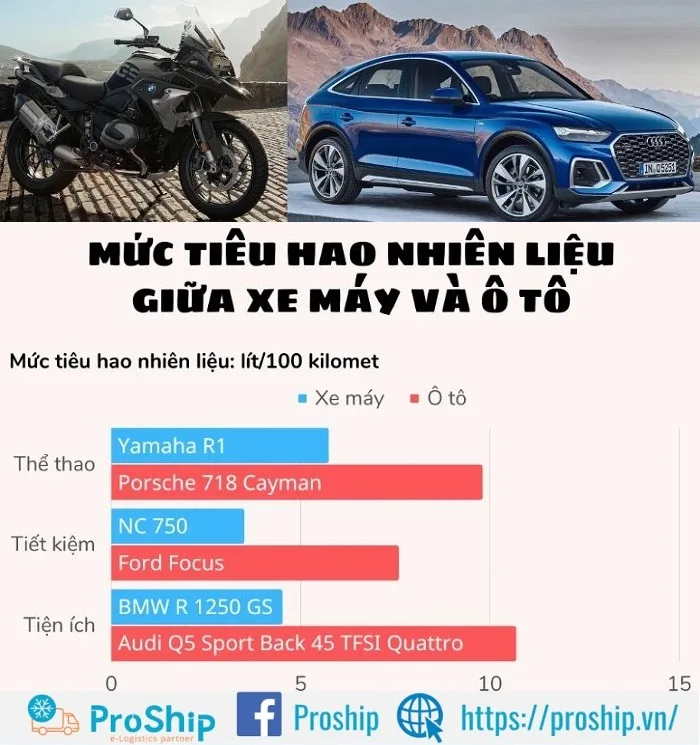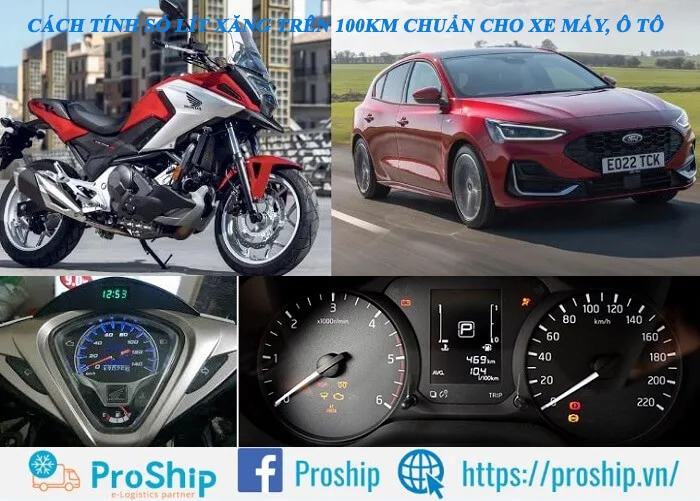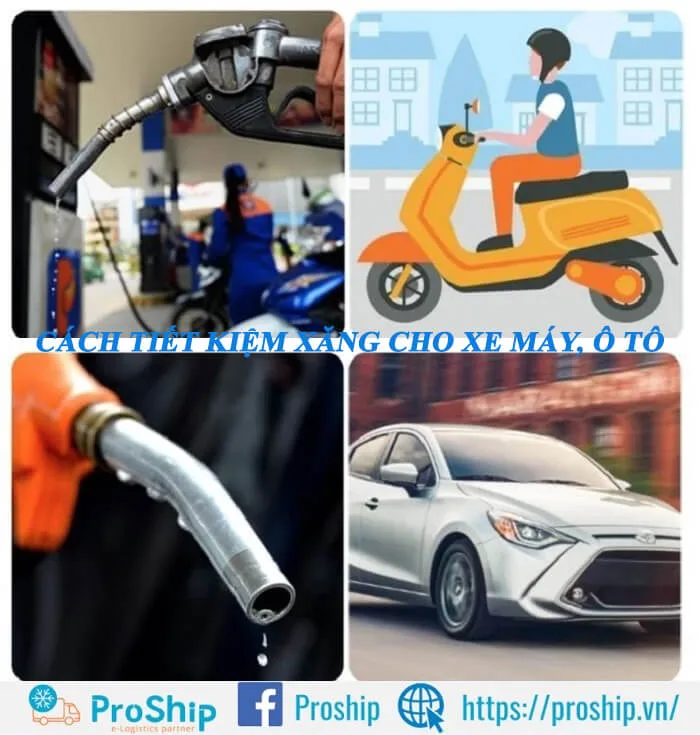Bạn muốn biết xe máy hay ô tô của mình tiêu hao bao nhiêu xăng/100km để tiết kiệm chi phí? Trung bình, xe máy phổ biến hiện nay như Honda Future, Sirius, Wave Alpha tiêu hao khoảng 1.5-1.7 lít xăng/100km. Còn ô tô chạy hỗn hợp khoảng 6-7 lít/100km, đường phố có thể lên 8-9 lít/100km. Bài viết này Proship.vn sẽ chỉ bạn công thức, cách tính số lít xăng trên 100km chuẩn cho xe máy, ô tô, cũng như mẹo tiết kiệm xăng hiệu quả nhất trong quá trình vận hành xe hằng ngày nhé!
📦 Hotline Liên Hệ Vận Chuyển
🧭 Miền Trung
Mức tiêu hao nhiên liệu của xe máy, ô tô trên 100km
Trung bình xe máy hết bao nhiêu xăng trên 100km?
Ví dụ về chiếc xe gắn máy 50 phân khối cơ bản, là loại tiêu tốn ít xăng nhất trong các loại xe máy kể cả xe phân khối lớn. Một chiếc xe 50cc thông thường chạy được quãng đường 60 – 70 km với 1 lít xăng. Như vậy, chứ chạy hết 100km thì xe 50cc sẽ tiêu hao từ 1.43 – 1.65 lít xăng.
Việc đi 100km hết bao nhiêu lít xăng xe máy phụ thuộc vào nhiều yếu tố như: Số phân khối của xe, chất lượng động cơ, thời gian sử dụng, thương hiệu sản xuất,…nên KHÔNG THỂ tính toán chuẩn xác.
Proship chia sẻ mức tiêu hao nhiên liệu của một số dòng xe nhất định trên thị trường hiện nay:
- Xe Honda Future: 1.54 lít/100km;
- Yamaha Sirius: 1,57 lít/100km;
- Yamaha Jupiter: 1,55 lít/100km;
- Honda Wave Alpha: 1,6 lít/100km;
- Yamaha Grande Hybrid: 1,69 lít/100km.
Thực tế, với tình trạng giá xăng cao ngất ngưởng và không có dấu hiệu giảm bớt như hiện nay thì chi phí xăng xe là điều đáng lưu tâm. Việc nắm rõ 100km hết bao nhiêu lít xăng xe máy giúp chọn được chiếc xe tiết kiệm nhiên liệu tốt nhất. Nói chung, 100km hết bao nhiêu lít xăng xe máy sẽ không có con số chính xác bởi còn tùy thuộc từng loại xe.

Trung bình xe ô tô bình thường tiêu hao xăng thế nào?
Mức tiêu thụ xăng phụ thuộc vào địa hình di chuyển là đường đô thị, đường trường,…Mỗi loại xe sẽ có những mức tiêu thụ khác nhau nên để biết xe mình ở mức tiêu thụ xăng tiết kiệm, bình thường hay là quá cao, bạn có thể tham khảo mức trung bình hiện nay:
- Với đường trường, lượng xăng tiêu thụ khoảng từ 4.5 lít/100km;
- Với làn đường hỗn hợp dao động từ 6 lít đến 7 lít xăng/100km;
- Đường phố, lượng xăng xe dao động từ 7 đến 9 lít/100km.
Bên cạnh đó, dung tích xe cũng sẽ có sự ảnh hưởng lớn đến quá trình tiêu thụ xăng xe. Thông thường các dòng xe có dung tích từ 1 đến 1.5 lít sẽ tiêu thụ thấp nhưng xe có dung tích 2 – 3 lít có mức tiêu thụ khá cao. Xe dung tích 2 lít, mức tiêu thụ thấp nhất là 7 lít/100km đường trường, đường phố khoảng 9 lít/100km trở lên.
>>Xem thêm: Mức tiêu hao nhiên liệu Suzuki 5 tạ
Cách tính số lít xăng tiêu thụ trên 100km cho xe máy, ô tô chuẩn nhất
Dưới đây là cách tính số lít xăng trên 100km dành cho xe ô tô và xe máy chuẩn xác nhất:
Cách tính 1 lít xăng ô tô đi được bao nhiêu km
Cách tính mức tiêu hao nhiên liệu xe ô tô thường được các nhà cung cấp xe tính theo công thức sau:
Mc = K1. L/100 + K2 . P/100 + nK3
* Trong đó:
- Mc: Tổng số nhiên liệu được cấp cho một chuyến xe (lít);
- K1: Định mức kỹ thuật (lít/100 km);
- K2: Phụ cấp có tải, có hành khách (lít);
- K3: Phụ cấp phải dừng đỗ để xếp, dỡ (khi có hàng, có hành khách);
- L: Tổng quãng đường xe chạy (có chở hàng và không chở hàng) sau khi đã quy đổi ra đường cấp 1 (km);
- P: Tổng khối lượng hàng hóa luân chuyển tính theo (T.km) hoặc (HK.km) sau khi đã quy đổi ra đường loại 1;
- n: Số lần xếp dỡ hàng hóa hoặc số lần dừng đỗ xe (trên 1 phút).
Tuy nhiên, theo kinh nghiệm của nhiều người lái xe thì công thức này không chỉ rườm rà mà còn cho kết quả ít sát thực tế. Do đó, các Chuyên gia lái xe đã đưa ra cách tính mức tiêu hao nhiên liệu cho xe mới như sau:
Bước 1: Đổ đầy xăng/dầu cho xe
Khi bắt đầu thực hiện phép tính, bạn phải đổ đầy bình xăng thì mới có thể tính chính xác mức tiêu hao năng lượng của xe ô tô dù mới hay cũ trong quá trình sử dụng.
Bước 2: Ghi nhớ con số cụ thể quãng đường đi trước đó
Tiếp theo, sau khi đổ đầy bình xăng, bạn cần phải ghi lại số Km mà xe đã đi được hiển thị trên thiết bị đo quãng đường trước khi lái xe khỏi trạm xăng.
Bước 3: Lái xe chạy đến khi chỉ còn ½ bình xăng
Khi bạn lái xe chạy và bình xăng chỉ còn lại một nửa sẽ giúp bạn lấy được số liệu đúng nhất về mức tiêu hao nhiên liệu của xe. Vì thế, bạn hãy cố gắng để số km chạy được càng nhiều thì càng tốt miễn sao đảm bảo cứ chạy hết nửa bình xăng.
Bước 4: Tiếp tục đổ đầy bình xăng lần thứ 2
Sau khi đã đi hết một nửa bình xăng, bước tiếp theo bạn tiếp tục đổ đầy bình xăng lần thứ 2. Và tốt nhất là lần đổ này vẫn là cây xăng ở lần một để đảm bảo cách tính mức tiêu hao nhiên liệu cho xe chuẩn nhất. Bạn lưu ý cần ghi lại số lượng xăng đã đổ ở lần 2 này.
Bước 5: Tiếp tục ghi lại quãng đường vừa đi được
Giống như lần 1, sau khi đã đổ xăng ở lần 2 này bạn tiếp tục ghi lại quãng đường cụ thể vừa đi được để tính mức tiêu hao nhiên liệu cho cả xe hơi được thuận tiện và chính xác.
Bước 6: Tính mức hao nhiên liệu với cách tính đơn giản
Sau khi đã có đủ số liệu đã ghi chép ở trên, bạn thực hiện cách tính mức tiêu hao nhiên liệu xe ô tô theo công thức đơn giản sau:
Mức tiêu hao nhiên liệu trung bình (lít/100km) = (quãng đường 1 – quãng đường 2)/ số lít xăng đã đổ

Cách tính 1 lít xăng xe máy đi được bao nhiêu km
Bước 1: Ghi lại số km hiện tại và đổ đầy bình
Việc đầu tiên bạn cần làm chính là khi lại số km (ODO) đã đi được. Sau đó hãy tới thẳng trạm xăng và đổ đầy bình. Nhưng để cho việc tính toán được chuẩn xác nhất, bạn hãy đảm bảo bình đã hết xăng hoặc còn không đáng kể nhé. Cũng tại bước này, bạn hãy ghi lại số lít xăng đã đổ.
Bước 2: Chạy xe trong điều kiện bình thường
Để tính mức tiêu hao nhiên liệu cho xe được đúng nhất, bạn hãy di chuyển trên những đoạn đường thường đi với cùng một vận tốc. Bạn nên chạy xe ở vận tốc 40 – 50km/h nếu di chuyển trong phố nhé. Lúc này chỉ cần chạy xe đến khi lượng xăng còn lại không đáng kể và số liệu thu được sẽ ít sai lệch hơn. Cách tính mức tiêu hao nhiên liệu cho xe cũng chuẩn xác hơn.
Bước 3: Ghi lại số km (ODO) mới
Sau khi hoàn thành bước 2, bạn hãy kiểm tra đồng hồ của xe để xem số km hiện tại là bao nhiêu nhé. Và cách tính mức tiêu hao nhiên liệu cho xe sẽ được tính theo công thức sau:
Mức tiêu hao xăng (lít/ 100km) = Số lít xăng đã đổ / (ODO mới – ODO cũ) x 100
* Ví dụ: Bạn đổ 3 lít (để đầy bình xăng được thực hiện tại bước 1). Số ODO cũ là 15,000 km. Sau khi chạy hết lượng xăng trong bình, số ODO mới là: 15,150 km. Như vậy, mức tiêu thụ nhiên liệu xe của bạn sẽ là: 3/ (15,150 – 15,00) x 100= 2. Con số này có nghĩa là: Bạn mất 2 lít xăng để di chuyển quãng đường dài 100km.
📦 Hotline Liên Hệ Vận Chuyển
🧭 Miền Trung
Proship Logistics chia sẻ mẹo tiết kiệm xăng cho xe máy, ô tô hiệu quả nhất
Như vậy, bạn đã biết được mức tiêu hao nhiên liệu cũng như cách tính số lít xăng trên 100km sao cho chuẩn xác. Tiếp theo đây sẽ là những mẹo hay giúp bạn tiết kiệm xăng hiệu quả cho xe máy và xe ô tô, CẦN BIẾT:
Mẹo tiết kiệm xăng khi sử dụng xe máy
để tối ưu quãng đường di chuyển và tiết kiệm nhiên liệu xe máy hiệu quả, người lái nên lưu ý:
- Theo dõi tình trạng lốp xe:
Đảm bảo lốp xe máy luôn căng khi di chuyển, bảo dưỡng lốp thường xuyên và tránh để lốp xe bị mòn trong thời gian dài. Xe máy di chuyển trong tình trạng lốp bị xẹp khiến động cơ hoạt động nhiều hơn, dẫn đến hao tốn nhiên liệu cao hơn mức bình thường.
- Lái xe với tốc độ vừa phải:
Duy trì tốc độ lái ổn định trong suốt hành trình. Việc tăng ga hoặc giảm tốc đột ngột không chỉ ảnh hưởng đến hệ thống động cơ mà còn khiến xe tiêu hao nhiên liệu ở mức cao.
- Tắt máy xe khi dừng đèn đỏ:
Tắt máy khi đèn đỏ có thời gian từ 30 giây trở lên giúp xe hạn chế tình trạng đốt nhiên liệu khi không cần thiết.
- Tránh đạp phanh và côn khi không cần thiết:
Thao tác này không chỉ làm mòn phanh mà còn tạo ra gánh nặng không cần thiết cho động cơ, khiến xe hoạt động mạnh và hao tốn nhiều nhiên liệu.
- Bảo dưỡng xe máy và thay dầu nhớt thường xuyên:
Đối với phương tiện đã di chuyển một khoảng thời gian dài, chủ xe nên chú ý thay nhớt và bảo dưỡng xe thường xuyên, giúp động cơ xe vận hành trơn tru và ít hao tốn xăng hơn.

Mẹo tiết kiệm xăng khi sử dụng xe ô tô
Sử dụng xăng với mức tiêu thụ cao thì tài chính là yếu tố bị ảnh hưởng đầu. Bạn muốn tiết kiệm chi phí sử dụng, cần tìm hiểu những cách tiết kiệm xăng. Dưới đây là một vài mẹo hay dành cho bạn:
- Tránh thói quen sử dụng như tăng tốc đột ngột khi vừa khởi động xe;
- Chủ động kiểm tra, bảo dưỡng xe. Lưu ý, việc vệ sinh xe, động cơ tránh việc các chất bẩn làm tắt nghẽn dầu nhớt khiến hệ thống bôi trơn bị gián đoạn làm ảnh hưởng;
- Duy trì ổn định tốc độ lái xe;
- Tắt điều hòa xe khi không cần thiết;
- Kiểm sát áp suất lốp xe thường xuyên, áp xuất thấp, lốp non hơn cũng gây trì trệ khi di chuyển. Nên sử dụng máy bơm lốp điện ô tô Medicar với các tính năng nổi bật cảnh báo áp suất và bơm hơi nhanh.
Câu hỏi thường gặp
1. Xe máy phổ biến tiêu hao xăng bao nhiêu lít/100km?
Khoảng 1.5-1.7 lít/100km với xe máy 50-125cc trong điều kiện đường hỗn hợp.
2. Xe ô tô hỗn hợp hết bao nhiêu xăng/100km?
Thường từ 6-7 lít/100km; nếu chạy phố hoặc tắc đường có thể lên 8-9 lít/100km.
3. Cách tính tiêu hao xăng thực tế như thế nào?
Đổ đầy bình lần 1 – ghi odo – chạy cho đến khi bình hết hoặc tới mức cụ thể – đổ lại lần 2 – lấy số lít đổ lần 2 / số km đã chạy × 100 = lít/100km.
4. Những yếu tố nào làm mức tiêu hao nhiên liệu thay đổi?
Dung tích động cơ, tình trạng xe, kiểu địa hình (đường trường vs đường phố), cách lái xe (tốc độ, tăng ga đột ngột…), lốp xe có đủ áp suất, bảo dưỡng xe định kỳ.
5. Làm sao để xe ô tô tiết kiệm xăng hơn khi di chuyển trong phố?
Giữ tốc độ ổn định, tránh tắc đường nếu được, sử dụng điều hòa hợp lý, kiểm tra áp suất lốp, bảo dưỡng định kỳ, tắt máy khi đèn đỏ lâu…
Trên đây là cách tính số lít xăng trên 100km dành cho xe máy, xe ô tô chuẩn nhất. Theo đó, nếu các bác tài đang có nhu cầu tìm hiểu về mức tiêu hao nhiên liệu của hai loại phương tiện thông dụng này thì hoàn toàn có thể tham khảo nội dung chia sẻ hữu ích trên…Và khi có nhu cầu sử dụng các loại hình Dịch vụ vận tải hàng hóa, bưu kiện, xe máy,…giá rẻ đi Bắc Nam tại Proship Logistics, liên hệ ngay 0909 344 247.
📦 Hotline Liên Hệ Vận Chuyển
🧭 Miền Trung

